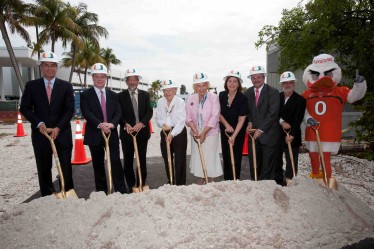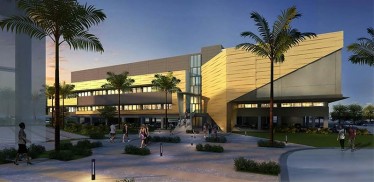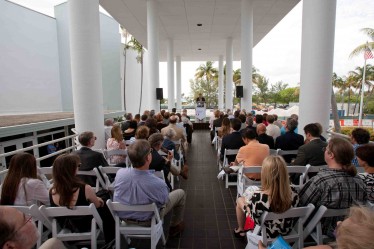
Groundbreaking occasion: participating in the groundbreaking ceremony were, from left, Thad Dameris, managing partner of Hogan Lovells’ Houston office; Alfred C. Glassell, III; Rosenstiel School Dean Roni Avissar; Marta Weeks Wulf, University trustee, and former chair of the UM Board of Trustees; Lady Blanka Rosenstiel; Stella Fiotes, chief facilities management officer at NIST; Thomas J. LeBlanc, executive vice president and provost; Leonard Abess, chair of the UM Board of Trustees; and Sebastian the Ibis.
Sea spray whipped up by the violent, swirling winds of a hurricane has long been a thorn in the side of researchers trying to determine its effect on storm forecasting.
“No one can accurately model what happens when the ocean is just so churned up that there’s so much water in the air and so much air in the water,” says Brian Haus, a professor of applied marine physics at the University of Miami. “It’s been a real ongoing challenge. You can’t model it, and it’s really difficult to measure in the field.”
But soon, a new facility that will house a 28,000-gallon tank will help scientists lift the haze surrounding sea spray, providing them with a scaled-down and controlled environment to observe the interaction between sea and air—which could ultimately lead to better hurricane forecasting.

A rendering of the Marine Technology and Life Sciences Seawater Complex, which is scheduled for completion in late 2013.
In a ceremony held just as the 2012 Atlantic Hurricane season gets under way, UM’s Rosenstiel School of Marine and Atmospheric Science broke ground June 7 on its $47 million Marine Technology and Life Sciences Seawater Complex—a “technological wonder” where researchers will study tropical cyclones and their impact on coastal structures.
“This is a proud moment for one of the University of Miami’s brightest jewels—the Rosenstiel School of Marine and Atmospheric Science,” said Thomas J. LeBlanc, executive vice president and provost, speaking to an audience of about 200 trustees, deans, administrators, faculty and staff members, students, and government officials. “The school has long been a center of excellence, thanks in great part to the widespread support it receives from all levels of government and our committed donors.”
Located amid Virginia Key’s thriving scientific and research community (an office of the National Oceanic and Atmospheric Administration is just across the causeway from Rosenstiel), the complex will house labs where oceanographers, meteorologists, marine physicists, and engineers study natural and manmade coastal structures and weather phenomena, as well as marine life that can impact human health.

An audience that included trustees, deans, administrators, faculty and staff members, students, and government officials listens to remarks during the groundbreaking ceremony for the new Marine Technology and Life Sciences Seawater Complex.
The facility is funded in part through a $15 million U.S. Department of Commerce American Recovery and Reinvestment Act grant awarded by the National Institute for Standards and Technology (NIST). Rosenstiel School Dean Roni Avissar noted that philanthropy would be essential to complete the project, and donations are being sought through UM’s Momentum2 campaign.
“The new complex will give us the opportunity to conduct state-of-the-art research on some of the most devastating storms affecting our area. This research will eventually result in more accurate hurricane forecasting, and in the construction of safer coastal structures,” said Avissar. “It will also help us to better understand our marine ecosystems, which are a precious resource and source of significant income for the region.”
Scheduled for completion in late 2013, the complex will consist of two buildings connected by an open atrium.
Occupying one of the buildings will be the Surge-Structure-Atmosphere Interaction (SUSTAIN) research laboratory, which will house a wind-wave-storm surge simulator capable of generating Category 5 hurricane force winds in a 3D environment. The 28,000 gallons of filtered seawater pumped into the building will allow scientists to directly observe and quantify critical storm factors such as sea spray and momentum transfers across the ocean’s surface in extreme wind conditions. A sophisticated wave generator will enable simulation of realistic storm surge impacts.
“Forcing, rapid intensification and storm surges—we still grapple with these oceanic and atmospheric processes that take place during extreme weather events,” said Haus, principal investigator and director of SUSTAIN. “This made-to-order tank, which is about the length of a bowling alley and the width of six bowling lanes, will provide us with a realistic, but scaled and controlled environment where we can observe different aspects of the interaction between sea and air to help us create more complete hurricane predictions. It will also provide an unprecedented opportunity for scientists to collaborate between disciplines to attempt to address the impact of extreme loads (wind and surge) on coastal structures and study how they withstand – or fail to withstand – the elements.”
Designed by the world’s leading aquarium architects, the new seawater tank enables the development and testing of building envelopes to protect critical structures during hazardous conditions, and will also be used to innovate advanced sensor technologies, including remote and optical imaging systems that can be deployed in hurricanes. This experimental test bed will contribute to the next generation of weather and climate simulation models that can help forecasters and emergency response planners throughout the hurricane season.
The Marine Life Sciences Center, occupying the other building, will provide a dedicated space for maintaining and studying living marine animals including fish, corals, and sea hares. Coral reef research will focus on helping to assess and measure the effects of climate change and ocean acidification on critical reef-building processes. Scientists will also conduct fisheries and biological oceanography research to generate models of the biological and physical processes that affect the distribution of marine organisms. They will also study the impacts of environmental toxicants including heavy metals, pharmaceuticals, and toxins on fishes and invertebrates, and use marine genomics to better understand how gene expression changes in marine populations chronically exposed to pollution. Studies on the relationship between the oceans and human health, including the effects of harmful algal blooms and novel pathways in carcinogenesis, will also take place in this building.
“Few facilities exist in the world where marine research is being conducted on such a wide range of aquatic organisms. The Marine Life Sciences Center will provide a dedicated space for the study of marine animals with special attention on the critical connections between oceans and human health and the impacts of climate change on marine organisms and ecosystems,” said Michael Schmale, co-principal investigator, Rosenstiel School associate dean for infrastructure, and professor of marine biology and fisheries.
The Marine Life Sciences Center will also house the National Resource for Aplysia, the only facility in the world that cultures and raises sea hares, Aplysia californica, for scientific research. “The relatively simple nervous system of Aplysia offers an ideal model for research on neurophysiology, brain function, memory and learning, and aging, which also have implications for human diseases such as Alzheimer’s,” added Schmale who is director of the National Resource for Aplysia.
The complex was designed by Cambridge 7 Associates and is being built by Suffolk Construction.
City of Miami Mayor Tomas Regalado called the complex “the icing on the cake” in Virginia Key’s redevelopment. He reeled off the names of 17 Miami neighborhoods, citing them as coastal communities that could benefit from the critical research that will take place in the new facility.
Others who spoke included Leonard Abess, chair of the UM Board of Trustees and the University’s Momentum2 campaign; Lady Blanka Rosenstiel, widow of the late Lewis Rosenstiel, for whom the school is named; Alfred C. Glassell III, son of the late Alfred C. Glassell Jr., for whom a building on the Rosenstiel campus is named; Village of Key Biscayne Mayor Frank Caplan; and Stella Fiotes, chief facilities management officer at NIST.







